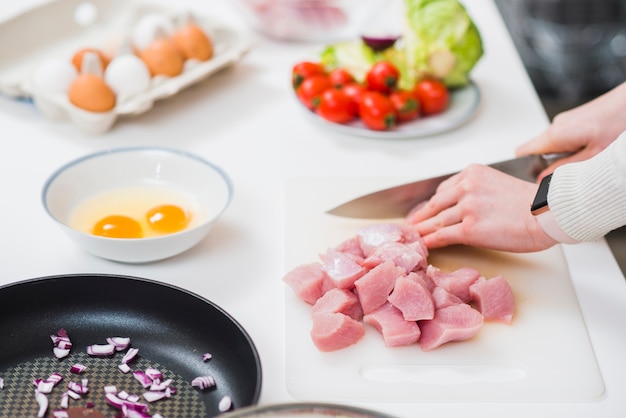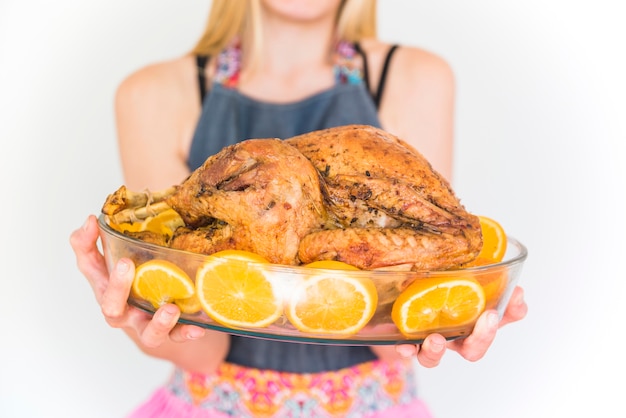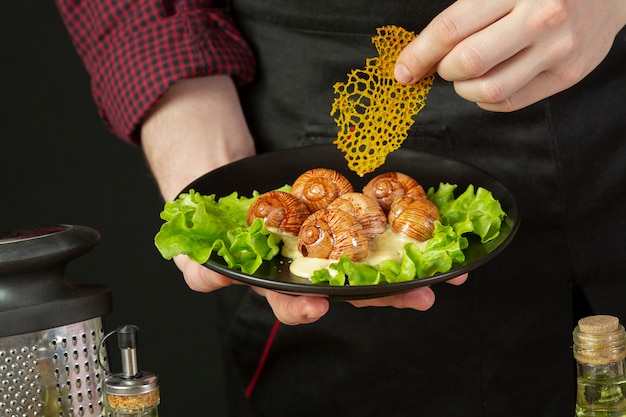(Part 1) The deep fryer Dilemma: A Frozen Chicken Conundrum

So, you're armed with your trusty deep fryer, prepped and ready to go. You've got a bag of frozen chicken nuggets, wings, or tenders, ready for transformation. The question is, how long do you cook them? And, let me tell you, it's not as simple as just throwing them in and hoping for the best. There are a few key factors you need to consider to get it right.
1. The Type of Chicken: A Tale of Nuggets, Wings, and More
Let's face it, not all chicken is created equal. Nuggets are smaller and thinner than wings, while tenders are a different shape than drumsticks. Each requires a slightly different cooking time. Nuggets, for example, will cook faster than those large drumsticks, which need more time to cook through to juicy perfection.
2. The Deep Fryer: Your Faithful Kitchen Companion
Every deep fryer is unique. Some heat up faster than others, and they might have different temperature settings. This is where your deep fryer's manual comes in handy. It will tell you the optimal temperature for frying, which will vary depending on the model. It's like your deep-fryer's secret recipe card!
3. The Frozen Factor: Managing the Steam Monster
The biggest challenge with deep-frying frozen chicken is the ice. When frozen chicken hits hot oil, it's like a tiny ice volcano erupting, creating a blast of steam that can cause the oil to splatter and the chicken to cook unevenly. We need to tame this steam to ensure our chicken cooks evenly and doesn't become a soggy mess.
(Part 2) Deep-Frying Frozen Chicken: Mastering the Art

Let's get down to the nitty-gritty. Here's my foolproof method for achieving the perfect deep-fried frozen chicken. It's all about preparing the chicken, managing the fryer, and timing it like a seasoned chef.
1. The Pre-Fry Ritual: Setting the Stage for Success
- Thaw it out: No, you cannot just throw frozen chicken straight into the deep fryer. That's a surefire way to create a kitchen disaster. Give those nuggets, wings, or tenders at least 30 minutes to thaw in the refrigerator. This helps ensure even cooking and minimizes the dreaded splatter fest.
- Dry it off: Once thawed, pat those chicken pieces dry with paper towels. This helps the batter or coating stick better and creates a crispier finish.
- Heat the oil: Preheat your deep fryer to the manufacturer's recommended temperature. A good starting point is around 350°F (175°C). Think of it like warming up your deep-fryer muscles before the big game.
2. The Plunge: A Gentle Descent Into Hot Oil
Now comes the exciting moment. The most important thing is to avoid overcrowding the fryer. Too much chicken in the fryer will cause the temperature to drop, resulting in soggy and undercooked chicken. So, add a small batch at a time, leaving space for the chicken to cook properly. Think of it as giving each piece its own little deep-fried spa treatment.
3. The Timer: Keeping It Precise
This is where things get a little tricky. The exact cooking time will vary depending on the size and type of chicken you're frying. But, here's a general guide to get you started:
| Chicken Type | Cooking Time (Approx.) |
|---|---|
| Nuggets | 2-3 minutes |
| Wings | 5-7 minutes |
| Tenders | 3-4 minutes |
| Drumsticks | 10-12 minutes |
Remember, these are just estimations. The best way to determine if your chicken is cooked is to use a meat thermometer. It should reach an internal temperature of 165°F (74°C) for safe consumption. Think of the meat thermometer as your deep-frying detective, ensuring a safe and delicious meal.
4. The Drain: A Quick Trip to the Wire Rack
Once your chicken is cooked, remove it from the deep fryer and place it on a wire rack to drain off the excess oil. This will prevent your chicken from becoming soggy and ensure a crispy finish. It's like giving your chicken a little post-deep-fry spa treatment to achieve that perfect crispy texture.
5. The Finishing Touches: Elevate Your Deep-Fried Creation
Now, here's where you can get creative! Serve your deep-fried chicken with your favourite dipping sauces, sprinkle it with spices, or add a touch of your favourite herbs for an extra flavour boost. Think of it as adding the finishing touches to a masterpiece.
(Part 3) Deep-Fried Chicken: Unveiling the Tips and Tricks

Now, I've shared my foolproof method for deep-frying frozen chicken, but there are a few extra tips and tricks that can elevate your game and take your deep-fried chicken to the next level.
1. The Batter Game: Creating a Crispy Outer Layer
- Homemade batter: You can use a store-bought batter mix, but for the ultimate crispy texture, whip up your own batter. There are countless recipes online, but a basic combination of flour, cornstarch, salt, and pepper is a good starting point.
- The breadcrumb trick: For extra crunch, dredge your chicken pieces in breadcrumbs before frying. You can use plain breadcrumbs, seasoned breadcrumbs, or even panko breadcrumbs for a Japanese twist.
- The "dry and wet" method: This technique involves dredging your chicken pieces in flour first, then dipping them in egg wash, and finally coating them in breadcrumbs. This creates multiple layers of texture and a super crispy exterior. It's like building a crispy armor for your chicken.
2. The Temperature Check: Ensuring Safety and Deliciousness
I can’t emphasize this enough: always use a meat thermometer to check the internal temperature of your chicken. It’s the only way to ensure it’s cooked through and safe to eat. Remember, undercooked chicken can be dangerous, so don't skip this step.
3. The Clean-Up Crew: Keeping Your Kitchen Spotless
Deep frying can be a messy affair, but it doesn’t have to be a nightmare. Here’s how to keep your kitchen in tip-top shape:
- The paper towel trick: Use paper towels to line your fryer basket. This will absorb some of the oil splatter and make clean-up a breeze.
- The cool-down method: Let the oil cool completely before pouring it into a container for storage. This prevents splashing and accidental spills.
- The soap and water solution: Use hot, soapy water to clean your deep fryer, but remember to unplug it before doing so.
(Part 4) The Deep-Fried Chicken Journey: My Personal Experiences
Over the years, I've had my fair share of deep-fried chicken disasters. I remember one particularly memorable incident where I attempted to fry a batch of frozen chicken nuggets without thawing them properly. The result? A catastrophic oil splatter that left my kitchen looking like a war zone. The nuggets were a soggy mess, and I ended up throwing the whole batch away.
But, through trial and error, I've learned a lot about the art of deep-frying frozen chicken. I've learned to appreciate the importance of proper thawing, the power of a good batter, and the value of a meat thermometer. I've also learned that a bit of patience goes a long way, especially when it comes to deep-frying. It's not a race, it's a delicious journey.
(Part 5) The Deep-Fried Chicken Dilemma: Frozen vs. Fresh
Now, you might be wondering, "Should I even bother with frozen chicken? Wouldn’t it be better to just use fresh chicken?" It's a fair question. Fresh chicken offers a more flavorful experience, but it also requires more effort in terms of preparation. It's like choosing between a quick takeout or a carefully prepared home-cooked meal.
Frozen chicken, on the other hand, is convenient and readily available. It's a good option when you're in a pinch or just don't have the time to deal with fresh chicken. But, remember, the secret to successful deep-fried frozen chicken is all about managing the thawing process and ensuring it cooks evenly.
(Part 6) The Deep-Fried Chicken Beyond Nuggets: Exploring Options
While deep-fried chicken nuggets are a classic choice, there are other delicious options to explore. Think of it as branching out from your comfort zone and discovering new deep-fried delights.
1. The Wing Man:
chicken wings are a popular choice for deep frying, and they’re incredibly versatile. You can toss them in your favourite sauce, or try a dry rub for a bolder flavour. Think of wings as your deep-fried blank canvas, ready for your culinary creativity.
2. The Tender Touch:
chicken tenders are another great option, offering a more delicate and tender texture. They're perfect for dipping in sauces, and they can be easily customised with different batters and coatings. Think of tenders as the elegant option, perfect for dipping and savoring.
3. The Drum Beat:
chicken drumsticks are a more substantial option that provides a nice juicy bite. Deep-fried drumsticks are often served with a side of mashed potatoes or gravy. Think of drumsticks as the hearty option, providing a satisfying crunch and juicy flavor.
(Part 7) The Deep-Fried Chicken Adventures: Recipe Inspiration
Ready to try your hand at deep-frying frozen chicken? Here are a few recipe ideas to inspire your culinary journey. Think of it as your deep-fried cookbook, ready to help you create deliciousness.
1. The Classic crispy chicken nuggets:
- Ingredients:
- 1 bag of frozen chicken nuggets
- 1 cup all-purpose flour
- 1 teaspoon salt
- 1/2 teaspoon black pepper
- 1/2 cup milk
- 1/2 cup breadcrumbs
- Instructions:
- Thaw the chicken nuggets in the refrigerator for 30 minutes.
- Whisk together the flour, salt, and pepper in a shallow dish.
- Dip each chicken nugget in the milk, then dredge it in the flour mixture, ensuring it’s fully coated.
- Heat the oil in a deep fryer to 350°F (175°C).
- Carefully lower the chicken nuggets into the hot oil, ensuring not to overcrowd the fryer.
- Fry for 2-3 minutes, or until golden brown and cooked through.
- Remove the chicken nuggets from the fryer and drain on a wire rack.
- Serve with your favourite dipping sauce.
2. The spicy buffalo wings:
- Ingredients:
- 1 bag of frozen chicken wings
- 1 cup all-purpose flour
- 1 teaspoon salt
- 1/2 teaspoon black pepper
- 1/2 teaspoon cayenne pepper
- 1/4 cup melted butter
- 1/4 cup hot sauce
- Instructions:
- Thaw the chicken wings in the refrigerator for 30 minutes.
- Whisk together the flour, salt, pepper, and cayenne pepper in a shallow dish.
- Dip each chicken wing in the flour mixture, ensuring it’s fully coated.
- Heat the oil in a deep fryer to 350°F (175°C).
- Carefully lower the chicken wings into the hot oil, ensuring not to overcrowd the fryer.
- Fry for 5-7 minutes, or until golden brown and cooked through.
- Remove the chicken wings from the fryer and drain on a wire rack.
- In a small bowl, whisk together the melted butter and hot sauce.
- Toss the chicken wings in the sauce until evenly coated.
- Serve immediately.
(Part 8) The Deep-Fried Chicken Journey: Final Thoughts
So, there you have it, my comprehensive guide to deep-frying frozen chicken. From thawing to frying and everything in between, I've covered all the essentials to ensure your next deep-fried chicken adventure is a success. It's like having your own personal deep-fried chicken mentor by your side.
Remember, the key to success lies in preparation, patience, and a little bit of culinary intuition. With a bit of practice and the right approach, you can conquer the deep-fried chicken challenge and create a delicious meal that will have everyone asking for more. It's like becoming a deep-fried chicken master chef in your own kitchen!
FAQs: Your Deep-Fried Chicken Questions Answered
1. What if my chicken isn't fully thawed?
If your chicken isn't fully thawed, it's best to put it back in the refrigerator until it's thawed properly. Cooking frozen chicken straight from the freezer can lead to uneven cooking and a soggy result. Patience is key when it comes to thawing.
2. How can I prevent oil splattering?
The best way to prevent oil splatter is to ensure your chicken is thawed and dry before frying. Also, avoid overcrowding the fryer, and lower the chicken into the hot oil carefully. Think of it as a gentle dance with the hot oil, avoiding any sudden movements.
3. What if my chicken is overcooked?
Overcooked chicken will be dry and tough. If your chicken is overcooked, there's not much you can do to salvage it. However, you can try to add a little moisture back by adding some gravy or sauce. Think of it as giving your overcooked chicken a little moisture boost.
4. Can I reuse deep fryer oil?
You can reuse deep fryer oil, but it's not recommended to use it more than a few times. After multiple uses, the oil can become contaminated with food particles and start to break down. If you do reuse oil, make sure to strain it and store it in a cool, dark place. Think of your deep fryer oil like a precious resource, using it wisely and respectfully.
5. What's the best way to clean my deep fryer?
Unplug your deep fryer before cleaning it. Use hot, soapy water to wash the exterior and interior of the fryer. You can also use a non-abrasive cleaner to remove any stubborn residue. Make sure to rinse the fryer thoroughly and dry it completely before storing it away. Think of cleaning your deep fryer as giving it a spa treatment, ensuring it's ready for your next deep-frying adventure.
Everyone is watching

How to Cook Frozen Lobster Tails Perfectly: A Step-by-Step Guide
RecipesLobster. Just the word conjures up images of lavish meals, special occasions, and a taste of luxury. But let's...

Pigs in a Blanket Cooking Time: How Long to Bake for Perfect Results
RecipesAh, pigs in a blanket. Just the name conjures up images of those delightful little parcels of crispy pastry en...

Pork Fillet Cooking Time: How Long to Cook It Perfectly
RecipesPork fillet, or tenderloin as it's sometimes called, is a real favourite in our house. It's so versatile, and...

The Ultimate Guide to Cooking Delicious Frankfurters
RecipesLet's face it, we all love a good frankfurter. It's a classic, simple, and always satisfying. But let's be rea...

Wolf Meat Recipes: A Guide to Cooking Wild Game
RecipesLet's be honest, you don't see wolf meat at your local butcher shop every day. It's a bit of a wild card, but ...
